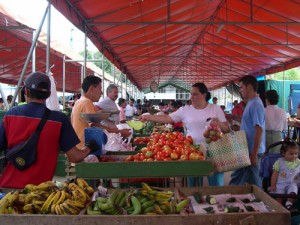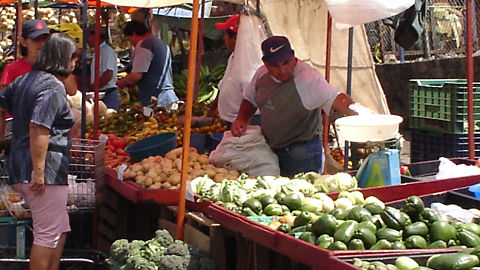Costa Rica English Teaching News – Part of the adventure of living abroad is the discovery of the little hidden gems that make your time away all the more special. While discovering these on your own can often times be the most rewarding, there are certain exceptions that buck this trend: those items that you – and your wallet – wished you had known about right from the very beginning. For me, the first item on this list is la feria.
 As an ESL teacher in Costa Rica, the most economical choice is often the right one. Living on less than $1,000 a month (in most cases), though not necessarily prohibiting, can certainly have its challenges. Where many hesitate to make sacrifices in what they buy is in food. While most have open minds about trying new cuisines and the tastes of different cultures, we all like what we like. The good news, in terms of buying groceries in Costa Rica, is that there are options to buy your trusted ingredients outside of the traditional venues.
As an ESL teacher in Costa Rica, the most economical choice is often the right one. Living on less than $1,000 a month (in most cases), though not necessarily prohibiting, can certainly have its challenges. Where many hesitate to make sacrifices in what they buy is in food. While most have open minds about trying new cuisines and the tastes of different cultures, we all like what we like. The good news, in terms of buying groceries in Costa Rica, is that there are options to buy your trusted ingredients outside of the traditional venues.
For the first calendar year that I lived in Costa Rica I bought one-hundred percent of my groceries in supermarkets. I did most of my shopping, based on the advice of local friends I had made, at more inexpensive chains – but they were still supermarkets. Sometime after that one year plateau, a friend of mine invited me to go with him one Saturday morning to la feria. I went along, to find out what it was, and my shopping patterns changed drastically.
As en ESL teacher in Costa Rica, if you use la feria, living on little income will become exponentially easier. La feria – The Market in English – is a farmer’s market that occurs every Saturday and Sunday in San José (if you live outside of San José the days change). The biggest ones are in Plaza Viquez on Saturdays and in Zapote on Sundays. However, with ferias also in Santa Ana, Escazú, Heredia and many other locations – including an organic feria – the options are plentiful and the commute is minimal, no matter where you reside.
Within the feria you can find just about anything you would find on your weekly grocery list. From fruits and vegetables to meat, fish, eggs, juice and even flowers, la feria is something that you should make a weekly occurrence.
Aside from the financial benefit, there are two other significant factors that come into play. The first is that all the produce is extremely fresh, often picked that same morning. Some of the best tasting fruits and vegetables that I’ve ever had have come from la feria. The trick is to not buy too much. As the produce is bought in a “ready to eat” state, it won’t last longer than five or six days. This would, if you do it correctly, coincide with your next weekly trip. In shopping at la feria, thinking in seven day intervals is best.
The other factor – and arguable the most important – is the vendors. The people you buy your weekly groceries from are the same people that grew them. By frequenting the feria you are not only cutting your grocery bill in half, but you are also supporting the local farmers and small companies that are often brushed aside by large supermarket chains.
La feria is one of the coolest things I’ve had the privilege of experiencing in my time in Costa Rica. You save a lot of money, start a first-name basis with the vendors you frequent the most, and give back to the local community that you are living in. I would strongly encourage every ESL teacher in Costa Rica to acquaint themselves with their local feria as soon as possible.
If you want more information about teaching English in Costa Rica or getting your TEFL or TESOL certificate in Costa Rica feel free to contact Andrew at the Global TESOL College or email andrew@globaltesolcostarica.com
Originally from Toronto, Canada, Woodbury is the academic director of Global TESOL College Costa Rica , a contributor to radio program This Week in Costa Rica (http://thisweekincostarica.com/), and an independent writer based in Costa Rica.

